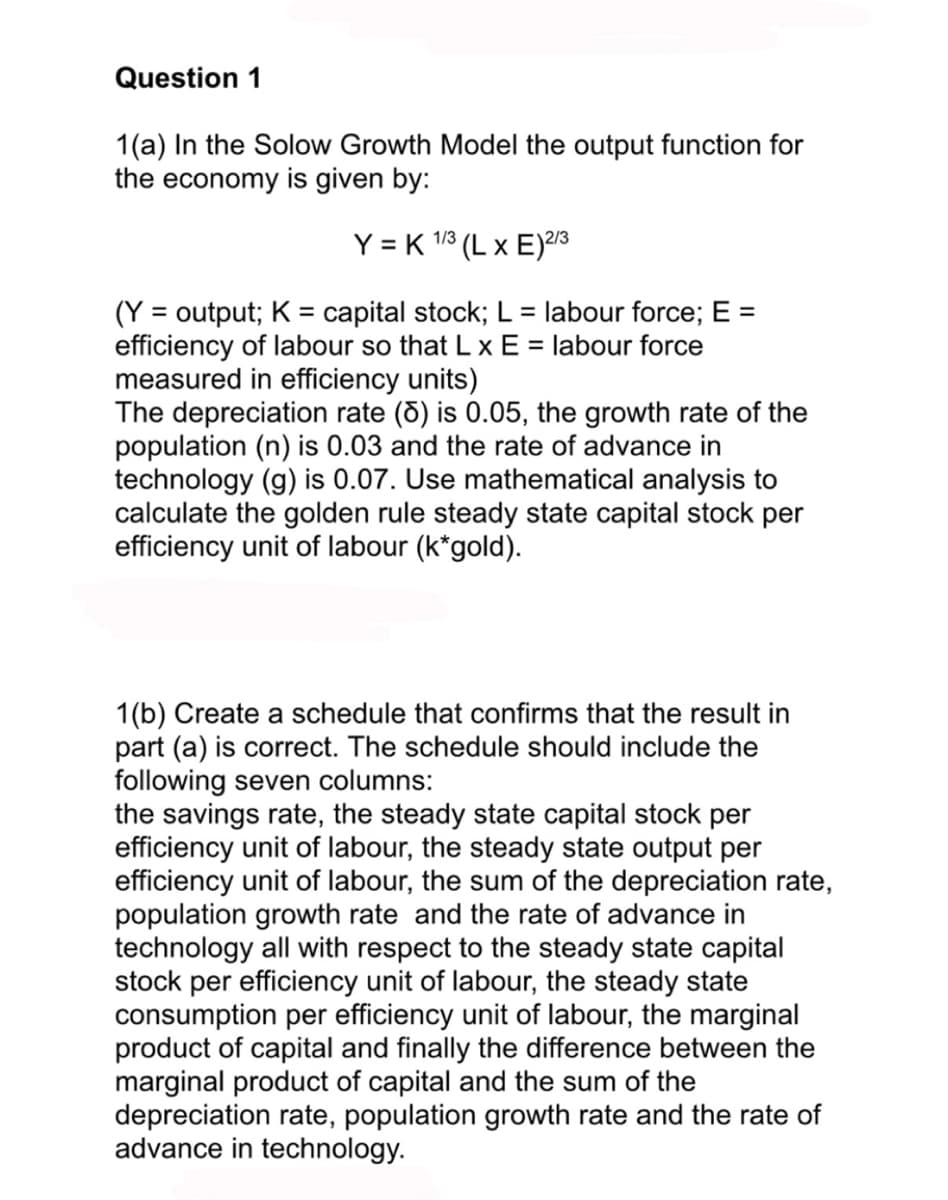Question 1 1(a) In the Solow Growth Model the output function for the economy is given by: Y = K 1/3 (L x E)2/3 (Y = output; K= capital stock; L = labour force; E = efficiency of labour so that L x E = labour force measured in efficiency units) The depreciation rate () is 0.05, the growth rate of the population (n) is 0.03 and the rate of advance in technology (g) is 0.07. Use mathematical analysis to calculate the golden rule steady state capital stock per efficiency unit of labour (k*gold). 1(b) Create a schedule that confirms that the result in part (a) is correct. The schedule should include the following seven columns: the savings rate, the steady state capital stock per efficiency unit of labour, the steady state output per efficiency unit of labour, the sum of the depreciation rate, population growth rate and the rate of advance in technology all with respect to the steady state capital stock per efficiency unit of labour, the steady state consumption per efficiency unit of labour, the marginal product of capital and finally the difference between the marginal product of capital and the sum of the depreciation rate, population growth rate and the rate of advance in technology.
Question 1 1(a) In the Solow Growth Model the output function for the economy is given by: Y = K 1/3 (L x E)2/3 (Y = output; K= capital stock; L = labour force; E = efficiency of labour so that L x E = labour force measured in efficiency units) The depreciation rate () is 0.05, the growth rate of the population (n) is 0.03 and the rate of advance in technology (g) is 0.07. Use mathematical analysis to calculate the golden rule steady state capital stock per efficiency unit of labour (k*gold). 1(b) Create a schedule that confirms that the result in part (a) is correct. The schedule should include the following seven columns: the savings rate, the steady state capital stock per efficiency unit of labour, the steady state output per efficiency unit of labour, the sum of the depreciation rate, population growth rate and the rate of advance in technology all with respect to the steady state capital stock per efficiency unit of labour, the steady state consumption per efficiency unit of labour, the marginal product of capital and finally the difference between the marginal product of capital and the sum of the depreciation rate, population growth rate and the rate of advance in technology.
Chapter1: Making Economics Decisions
Section: Chapter Questions
Problem 1QTC
Related questions
Question

Transcribed Image Text:Question 1
1(a) In the Solow Growth Model the output function for
the economy is given by:
Y = K 1/3 (L x E) 2/3
(Y = output; K = capital stock; L = labour force; E =
efficiency of labour so that L x E = labour force
measured in efficiency units)
The depreciation rate (8) is 0.05, the growth rate of the
population (n) is 0.03 and the rate of advance in
technology (g) is 0.07. Use mathematical analysis to
calculate the golden rule steady state capital stock per
efficiency unit of labour (k*gold).
1(b) Create a schedule that confirms that the result in
part (a) is correct. The schedule should include the
following seven columns:
the savings rate, the steady state capital stock per
efficiency unit of labour, the steady state output per
efficiency unit of labour, the sum of the depreciation rate,
population growth rate and the rate of advance in
technology all with respect to the steady state capital
stock per efficiency unit of labour, the steady state
consumption per efficiency unit of labour, the marginal
product of capital and finally the difference between the
marginal product of capital and the sum of the
depreciation rate, population growth rate and the rate of
advance in technology.
Expert Solution
This question has been solved!
Explore an expertly crafted, step-by-step solution for a thorough understanding of key concepts.
Step by step
Solved in 3 steps

Knowledge Booster
Learn more about
Need a deep-dive on the concept behind this application? Look no further. Learn more about this topic, economics and related others by exploring similar questions and additional content below.Recommended textbooks for you


Principles of Economics (12th Edition)
Economics
ISBN:
9780134078779
Author:
Karl E. Case, Ray C. Fair, Sharon E. Oster
Publisher:
PEARSON

Engineering Economy (17th Edition)
Economics
ISBN:
9780134870069
Author:
William G. Sullivan, Elin M. Wicks, C. Patrick Koelling
Publisher:
PEARSON


Principles of Economics (12th Edition)
Economics
ISBN:
9780134078779
Author:
Karl E. Case, Ray C. Fair, Sharon E. Oster
Publisher:
PEARSON

Engineering Economy (17th Edition)
Economics
ISBN:
9780134870069
Author:
William G. Sullivan, Elin M. Wicks, C. Patrick Koelling
Publisher:
PEARSON

Principles of Economics (MindTap Course List)
Economics
ISBN:
9781305585126
Author:
N. Gregory Mankiw
Publisher:
Cengage Learning

Managerial Economics: A Problem Solving Approach
Economics
ISBN:
9781337106665
Author:
Luke M. Froeb, Brian T. McCann, Michael R. Ward, Mike Shor
Publisher:
Cengage Learning

Managerial Economics & Business Strategy (Mcgraw-…
Economics
ISBN:
9781259290619
Author:
Michael Baye, Jeff Prince
Publisher:
McGraw-Hill Education